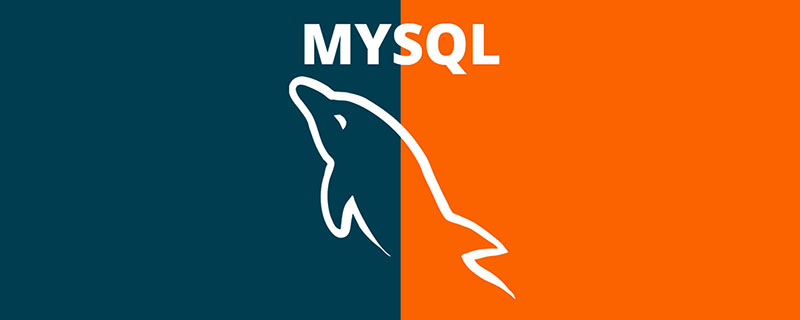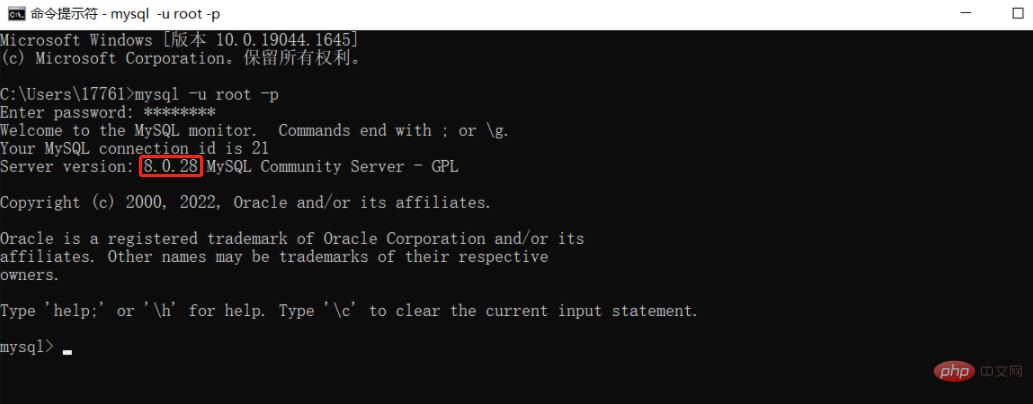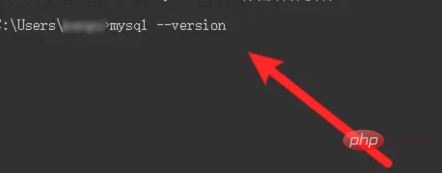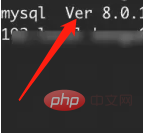What are the mysql version query commands?
Mysql version query commands include: 1. "mysql -uroot -p" command, which will output version information when logging in to the mysql database; 2. "select version();" command, which can query the mysql server version; 3. "status" command, you can view the server profile information including the version number; 4. "mysql --version" command, you can query the version information of mysql without connecting to the MySQL server.

The operating environment of this tutorial: Windows 7 system, Dell G3 computer.
Sometimes we need to check the version information of mysql, then we can refer to the following method.
1. Use the "mysql -uroot -p" command
Log in to mysql on the command line and you will see the version number of mysql

2. Use the "select version();" command
Enter the "select version();" command and press the Enter key. See querying the mysql and postgresql server-side versions

3. Use the "status" command
status command to view server overview information, Including version information
Just enter the "status" command and press Enter

4. Use the "mysql --version" command


Note: Method 4 does not require logging into mysql. You can query the version information of mysql without connecting to the MySQL server.
Extended knowledge: Mysql version and version number
For different users, MySQL is divided into two versions:
MySQL Community Server (Community Edition): This version is completely free, but official technical support is not provided.
MySQL Enterprise Server (Enterprise Edition): This version can provide data warehouse applications for enterprises at a very high cost performance, supports ACID transaction processing, and provides complete commit, rollback, and crash recovery. and row-level locking functions, but this version requires payment, and the official provides telephone technical support.
Note: MySQL Cluster is mainly used to set up group servers and needs to be used on the basis of community services or enterprise edition.
MySQL’s naming mechanism consists of 3 numbers and 1 suffix, for example, mysql-5.7.20:
The first number" 5" is the major version number and is used to describe the format of the file. All version 5 releases have the same folder format.
The second number "7" is the release level. The combination of the major version number and the release level constitutes the release serial number.
The third number "20" is the version number in this release series, which increases with each new release. Usually choose the latest version that has been released.
In the MySQL development process, there are multiple release series at the same time, and the maturity of each release series is at different stages.
MySQL 5.7 is the latest stable (GA) release series that will implement new features and is currently available for normal use.
MySQL 5.6 is a relatively stable (GA) release series. It is only re-released for bug fixes and does not add new features that will affect stability.
MySQL 5.1 is a stable (product quality) release series that is re-released only for critical bug fixes and security fixes, without adding important features that affect the stability of the series.
Note: Official support for MySQL 4.1 and other older versions lower than 5.0 will no longer be provided. All released versions of MySQL have been tested to strict standards to ensure they are safe and reliable to use. For different operating systems, readers can download the corresponding installation files from the MySQL official download page (http://dev.mysql.com/downloads/).
[Related recommendations: mysql video tutorial]
The above is the detailed content of What are the mysql version query commands?. For more information, please follow other related articles on the PHP Chinese website!

Hot AI Tools

Undresser.AI Undress
AI-powered app for creating realistic nude photos

AI Clothes Remover
Online AI tool for removing clothes from photos.

Undress AI Tool
Undress images for free

Clothoff.io
AI clothes remover

Video Face Swap
Swap faces in any video effortlessly with our completely free AI face swap tool!

Hot Article

Hot Tools

Notepad++7.3.1
Easy-to-use and free code editor

SublimeText3 Chinese version
Chinese version, very easy to use

Zend Studio 13.0.1
Powerful PHP integrated development environment

Dreamweaver CS6
Visual web development tools

SublimeText3 Mac version
God-level code editing software (SublimeText3)

Hot Topics
 1655
1655
 14
14
 1413
1413
 52
52
 1306
1306
 25
25
 1252
1252
 29
29
 1226
1226
 24
24
 MySQL's Role: Databases in Web Applications
Apr 17, 2025 am 12:23 AM
MySQL's Role: Databases in Web Applications
Apr 17, 2025 am 12:23 AM
The main role of MySQL in web applications is to store and manage data. 1.MySQL efficiently processes user information, product catalogs, transaction records and other data. 2. Through SQL query, developers can extract information from the database to generate dynamic content. 3.MySQL works based on the client-server model to ensure acceptable query speed.
 How to start mysql by docker
Apr 15, 2025 pm 12:09 PM
How to start mysql by docker
Apr 15, 2025 pm 12:09 PM
The process of starting MySQL in Docker consists of the following steps: Pull the MySQL image to create and start the container, set the root user password, and map the port verification connection Create the database and the user grants all permissions to the database
 Laravel Introduction Example
Apr 18, 2025 pm 12:45 PM
Laravel Introduction Example
Apr 18, 2025 pm 12:45 PM
Laravel is a PHP framework for easy building of web applications. It provides a range of powerful features including: Installation: Install the Laravel CLI globally with Composer and create applications in the project directory. Routing: Define the relationship between the URL and the handler in routes/web.php. View: Create a view in resources/views to render the application's interface. Database Integration: Provides out-of-the-box integration with databases such as MySQL and uses migration to create and modify tables. Model and Controller: The model represents the database entity and the controller processes HTTP requests.
 Solve database connection problem: a practical case of using minii/db library
Apr 18, 2025 am 07:09 AM
Solve database connection problem: a practical case of using minii/db library
Apr 18, 2025 am 07:09 AM
I encountered a tricky problem when developing a small application: the need to quickly integrate a lightweight database operation library. After trying multiple libraries, I found that they either have too much functionality or are not very compatible. Eventually, I found minii/db, a simplified version based on Yii2 that solved my problem perfectly.
 Laravel framework installation method
Apr 18, 2025 pm 12:54 PM
Laravel framework installation method
Apr 18, 2025 pm 12:54 PM
Article summary: This article provides detailed step-by-step instructions to guide readers on how to easily install the Laravel framework. Laravel is a powerful PHP framework that speeds up the development process of web applications. This tutorial covers the installation process from system requirements to configuring databases and setting up routing. By following these steps, readers can quickly and efficiently lay a solid foundation for their Laravel project.
 How to install mysql in centos7
Apr 14, 2025 pm 08:30 PM
How to install mysql in centos7
Apr 14, 2025 pm 08:30 PM
The key to installing MySQL elegantly is to add the official MySQL repository. The specific steps are as follows: Download the MySQL official GPG key to prevent phishing attacks. Add MySQL repository file: rpm -Uvh https://dev.mysql.com/get/mysql80-community-release-el7-3.noarch.rpm Update yum repository cache: yum update installation MySQL: yum install mysql-server startup MySQL service: systemctl start mysqld set up booting
 MySQL and phpMyAdmin: Core Features and Functions
Apr 22, 2025 am 12:12 AM
MySQL and phpMyAdmin: Core Features and Functions
Apr 22, 2025 am 12:12 AM
MySQL and phpMyAdmin are powerful database management tools. 1) MySQL is used to create databases and tables, and to execute DML and SQL queries. 2) phpMyAdmin provides an intuitive interface for database management, table structure management, data operations and user permission management.
 MySQL vs. Other Programming Languages: A Comparison
Apr 19, 2025 am 12:22 AM
MySQL vs. Other Programming Languages: A Comparison
Apr 19, 2025 am 12:22 AM
Compared with other programming languages, MySQL is mainly used to store and manage data, while other languages such as Python, Java, and C are used for logical processing and application development. MySQL is known for its high performance, scalability and cross-platform support, suitable for data management needs, while other languages have advantages in their respective fields such as data analytics, enterprise applications, and system programming.




